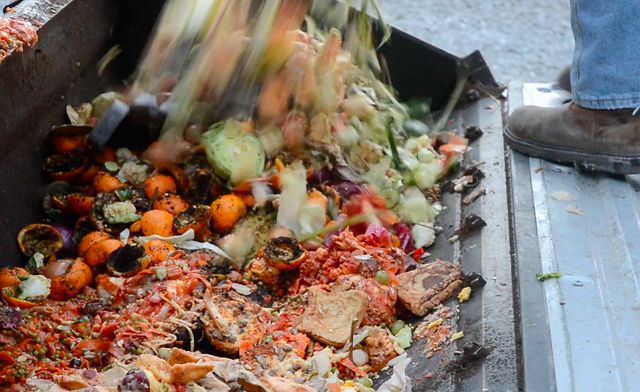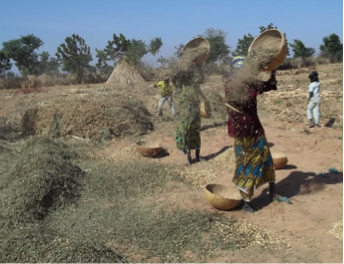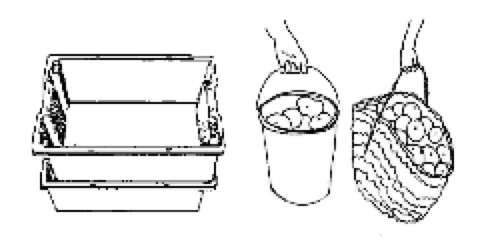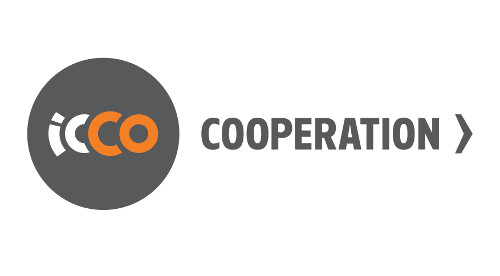Difference between revisions of "Addressing Food Loss and Waste"
(Made additions to temperature and humidity control by providing additional useful technologies.) (Tag: Visual edit) |
(→Acknowledgements) (Tag: Visual edit) |
||
| Line 93: | Line 93: | ||
* Movie: FAO: [https://www.youtube.com/watch?v=_Uf5SJcFlco Fishing women used improve post-harvest fishery technologies to reduce losses, increase income and household food security] | * Movie: FAO: [https://www.youtube.com/watch?v=_Uf5SJcFlco Fishing women used improve post-harvest fishery technologies to reduce losses, increase income and household food security] | ||
* CFS, HLPE repor 8, 2014. [http://www.fao.org/3/a-i3901e.pdf Food losses and waste in the context of sustainable food systems]. | * CFS, HLPE repor 8, 2014. [http://www.fao.org/3/a-i3901e.pdf Food losses and waste in the context of sustainable food systems]. | ||
| + | * Eric Verploegen, Peter Rinker and Kukom Edoh Ognakossan. Evaporative Cooling Best Practices, Producing and using evaporative cooling chambers and clay pot coolers. June 2018. http://d-lab.mit.edu/sites/default/files/Evaporative%20Cooling%20Best%20Practices%20Guide.pdf | ||
Revision as of 22:15, 13 August 2018

Addressing food loss and waste, requires looking at the whole food system. There are many different actors in the value chain that each play their roll in food loss and waste, which makes the reduction of food loss and waste a shared responsibility.
Addressing food loss and waste, begins with knowing which product groups are lost or wasted, at what point along the value chain, what the causes are and how they can be avoided (or not). Inclusive value chain platforms, can enable streamlined communication and planning, that helps reducing inefficiencies that can contribute to food loss and waste. Actors involved include farmers, input suppliers, transporters, traders, retailers, policymakers and bankers.
Addressing food loss and waste should be embedded in a broader concept of sustainable food systems, including sustainable food production on one hand and sustainable diets and consumptions on the other.
Top 10 category causes of post-harvest food losses:
(Source: WUR, 2013) |
Considerations for design and implementation of measurements throughout the food system include:
- Obtain sufficient knowledge about the causes and sources of food loss and waste.
- Measurements should be environmental sustainable
- Measurements should be profitable, or at least cost-effective, for the indicated value chain actors.
- Technologies should match the (local) context and needs of the user. When looking specifically at small holders (farmers, traders, entrepreneurs), large scale and expansive operations may not be practical or possible. Solutions should be appropriate in conditions like: labour surplus, lack of credit for investment in post-harvest technologies, unreliable electric power supply, lack of transport options, storage facilities and/or packaging materials etc.
- Different productive and social roles that men and women play at the different stages of the value chain. These are often underlying causes of food loss and waste.
| Women in many poor countries grow and process perishable crops and play therefore a key role in reducing food losses at the production, post-harvest and processing stages. Women face however many barriers, such as the lack of knowledge, access to tools or exclusion from producer organizations. More information can be found on SciDevNet and a practical toolkit on how to integrate a gender perspective in agricultural value chains, can be found here: AgriProFocus. |
The table below describes important causes of food loss and waste in developing countries and solutions to reduce them. The list is far from complete, therefore suggestions for further reading and sources are provided.
| Reasons / causes of food loss and waste | Solutions / approaches to prevent or reduce loss or waste |
| Production exceeds demand To anticipate unpredictable bad weather or pest attacks, farmers sometimes make production plans on the safe side and produce larger quantities than needed. Surplus crops are for example sold to processors or as animal feed. |
Better organized small farmers, technology transfer, education Communication and cooperation between farmers can reduce overproduction by allowing surplus crops from one farm to solve a shortage of crops on another. |
| Losses due to premature or late harvesting Poor farmers sometimes harvest too early due to food deficiency, desperate need for cash or by mistake. Food incurs a loss in nutritional and economic value and gets wasted if it is not suitable for consumption. |
Using a maturity index as standard will greatly reduce these type of losses. This might involve the use of a (hand-held) refractometer, firmness test or penetrometer. For more information, see: Manual for Horticultural Crops: Small-Scale Postharvest Handling Practices, p.7. (Kitinoja and Kader, 2002). |
| Inefficient harvesting practices and poor and/ or rough handling |
Proper (and simple) tools such as clean knives, picking bags, clippers, plastic sheets etc. use them in a way that prevent damage to the product. Gentle digging, picking and handling; |
| Poor quality packaging Poor quality packaging as the result of a lack of knowledge or the lack of available material, especially those that meet international market requirements. In many developing countries there is little domestic demand for packaging materials, that leads to low investment in the packaging industry, which limits the ability to enhance product quality of packaging material, to meet increasing discriminating consumers, both in domestic and international markets. |
Improved packages and containers (on the farm, during transport, during storage, for marketing) Simple buckets or harvesting containers are better as baskets in protecting produce. Plastic or metal crates are durable and easy to clean and store, but more expensive. Container standardization is a cost reduction strategy and gave rise to a wider range of package sized to accommodate the diverse needs of wholesalers, consumers, food service buyers and processing operations. |
| Poor management of temperature and a lack of cooling systems, can cause huge post-harvest loss, especially in hot climates. Keeping products at their lowest safe temperature will increase storage life by lowering respiration rate, decreasing sensitivity to ethylene gas and reducing water loss (not too cool). | Temperature and relative humidity control: A variety of simple cooling methods exist where electricity is unavailable or too expensive, such as night air ventilation, underground or high altitude storage, use of shade, cool water, ice, on-farm cool storage, CoolBot TM cold room, and evaporative cooling devices such as "Zero Energy Cooling Chambers (ZECCs)", clay pot coolers, and “Zeer pots". Both the private and public sector should invest in storage and cold chain facilities.
See Addressing Food Loss and Waste - Examples for examples. |
| Lack of infrastructure and means for transportation and marketing | Public and Private sector investments are needed for infrastructure and transportation, such as in roads, energy and market facilities. |
| Lack of processing facilities
Seasonality increases cost of processing facilities as they are not be used year-round. |
Processing is key for increasing shelf live and diversifying market opportunities for producers and availability for consumers. Small-scale tailor made processing techniques are important e.g. solar drying of fruits and vegetables or making jams, juices, candies, pickling, fermenting, sauces. Drying is one of the best ways to transfer perishable goods into shelf-stable products, however open air solar drying (still very common) is not efficient and unhygienic. |
Acknowledgements
- FAO, 2011-b Appropriate food packaging solutions for developing countries
- Global Knowledge Initiative, 2010. Reduce Global Food Waste and Spoilage. A Rockefeller Foundation Initiative. Assessing resources needed and available for reduce post-harvest food loss in Africa.
- Kitinoja and Kader, 2002. Small-Scale Postharvest Handling Practices: A manual for Horticultural Crops’ Fourth Edition. University of California, David. Postharvest Technology Research and Information Centre.
- SciDevNet, 2013 Focus on Gender: Women can help lower food losses, Blog: H. Miers, 2013
- Movie: FAO: Fishing women used improve post-harvest fishery technologies to reduce losses, increase income and household food security
- CFS, HLPE repor 8, 2014. Food losses and waste in the context of sustainable food systems.
- Eric Verploegen, Peter Rinker and Kukom Edoh Ognakossan. Evaporative Cooling Best Practices, Producing and using evaporative cooling chambers and clay pot coolers. June 2018. http://d-lab.mit.edu/sites/default/files/Evaporative%20Cooling%20Best%20Practices%20Guide.pdf



